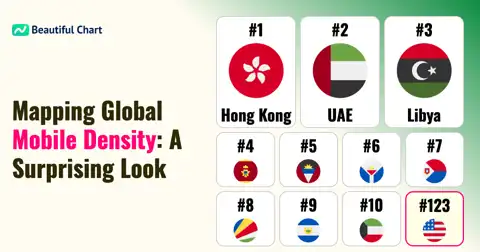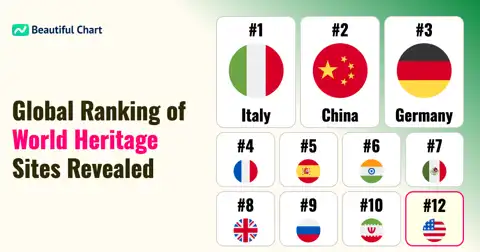This chart ranks countries by their total land area in square kilometers, highlighting the world's largest nations by territory. Russia leads with the most extensive area, covering over 16 million square kilometers, followed by China, the United States, and Canada, each with over 9 million square kilometers. The top ten list includes Brazil, Australia, and Algeria, showcasing geographic diversity across continents.
Land area refers to the total surface area of a country's territory, measured in square kilometers, encompassing all land within national borders. Land area impacts various factors including resource availability, biodiversity, and population distribution, often influencing a nation's economy and regional influence.
The global ranking of countries by land area underscores the vast geographic range of national territories, highlighting substantial size differences among the top-ranking nations. Russia, at over 16 million square kilometers, claims the largest land area, spanning Europe and Asia and nearly doubling the size of the next-largest country, China. This considerable size gives Russia a strategic advantage in resource diversity and geopolitical influence. China, the United States, and Canada follow, with each having a land area above 9 million square kilometers, reflecting their vast natural resources and varied climates.
Brazil is the largest country in South America and the fifth largest globally, covering approximately 8.35 million square kilometers, giving it a considerable share of the Amazon rainforest, a critical environmental zone. Australia, the largest country in Oceania and the sixth worldwide, showcases a unique environment with vast deserts and biodiversity. India, Argentina, and Kazakhstan round out the top nine, each with land areas between 2.7 and 3 million square kilometers, while Algeria, Africa's largest country, ranks tenth at 2.38 million square kilometers. This chart emphasizes the global distribution of land mass, with substantial territories in both highly populated and sparsely populated regions, shaping each nation's economic and environmental policies.
Examining the lower rankings, such as the United Kingdom at 80th with 242,000 square kilometers, provides a contrast, reflecting smaller territorial boundaries for some globally influential countries. The substantial difference between top-tier and lower-tier countries by land area highlights the geographic and developmental variations that influence each nation's resources, infrastructure, and global role. Overall, this ranking reveals how land area shapes national economies, biodiversity, and geopolitical standing on the world stage.
| Rank | Name | Indicator |
|---|---|---|
1 | Russia | 16M ㎢ |
2 | China | 9M ㎢ |
3 | United States | 9M ㎢ |
4 | Canada | 9M ㎢ |
5 | Brazil | 8M ㎢ |
6 | Australia | 7M ㎢ |
7 | India | 2M ㎢ |
8 | Argentina | 2M ㎢ |
9 | Kazakhstan | 2M ㎢ |
10 | Algeria | 2M ㎢ |
11 | Democratic Republic of the Congo | 2M ㎢ |
12 | Greenland | 2M ㎢ |
13 | Saudi Arabia | 2M ㎢ |
14 | Mexico | 1M ㎢ |
15 | Indonesia | 1M ㎢ |
16 | Libya | 1M ㎢ |
17 | Sudan | 1M ㎢ |
18 | Mongolia | 1M ㎢ |
19 | Iran | 1M ㎢ |
20 | Peru | 1M ㎢ |





